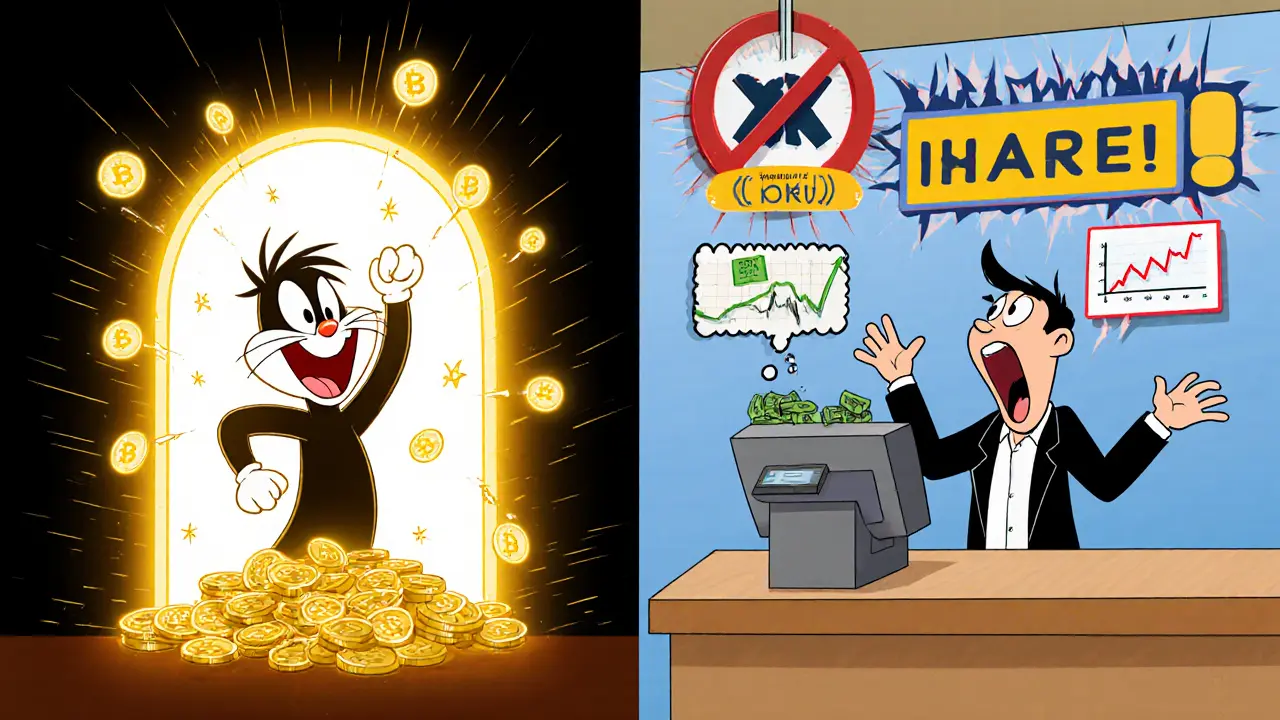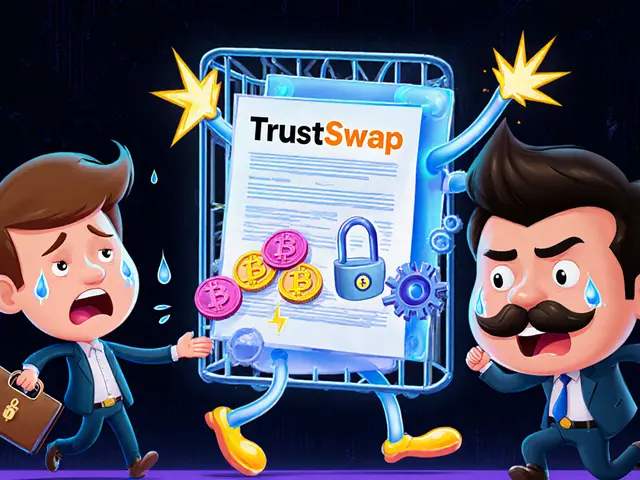
Compound Lending Calculator
Calculate Your Earnings
See how much interest you could earn by lending crypto on Compound. Rates change based on supply and demand.
Your Estimated Earnings
Note: Interest rates on Compound change constantly based on market conditions. The rates shown here are examples based on current average rates (DAI: ~3.8%, ETH: ~4.5%, USDC: ~3.9%). Actual rates may differ significantly. Compound does not guarantee any returns.
Compound is a lending protocol - you cannot trade or exchange assets on this platform. You need to first deposit crypto into Compound through a wallet like MetaMask.
There is no such thing as a 'Compound crypto exchange.' If you're searching for one, you're not alone - many people get confused because the name 'Compound' is everywhere in crypto, but not where they think it is. Compound isn't a place to buy or sell Bitcoin, Ethereum, or any other coin like Binance or Coinbase. It doesn't have a trading platform, order books, or a mobile app you can download. Instead, Compound is a decentralized lending protocol built on Ethereum. It lets you lend your crypto and earn interest, or borrow against your holdings. That’s it. No trading. No spot markets. No limit orders. No fiat on-ramps. If you're looking to trade crypto, Compound won't help you. But if you want to put your idle ETH or DAI to work, it’s one of the most trusted tools in DeFi.
What Compound Actually Does
Compound launched in 2018 and quickly became one of the first major DeFi protocols to prove that lending crypto without a bank was possible. It works by pooling together user deposits - like ETH, USDC, DAI, or LINK - and then lending them out to borrowers who pay interest. The interest rates you earn aren’t fixed. They change in real time based on supply and demand. If lots of people want to borrow DAI, the interest rate for lending DAI goes up. If no one’s borrowing, the rate drops. This dynamic system is managed entirely by smart contracts. No human approves your loan. No customer service team handles your withdrawal. It’s code, running on the Ethereum blockchain.
Users deposit crypto into Compound’s pools and receive cTokens in return. For example, if you deposit 100 DAI, you get 100 cDAI. These cTokens represent your share of the pool and accrue interest automatically. You can redeem your cDAI back to DAI anytime, plus the interest earned. The protocol has handled over $15 billion in total value locked (TVL) at its peak in 2021, and still holds more than $1.2 billion as of October 2025. That’s more than most centralized exchanges have in reserves.
Why People Think Compound Is a Crypto Exchange
The confusion comes from how DeFi tools are marketed. Many crypto influencers say things like, ‘Earn 5% on your crypto with Compound’ - and then link to a DeFi dashboard. New users assume that means they can buy, sell, and trade. But Compound doesn’t let you swap tokens. You can’t trade ETH for BTC on Compound. You can only deposit one asset and earn interest on it, or borrow another asset by locking up collateral. If you want to trade, you need to go to an exchange first - like Kraken, Binance, or Coinbase - then move your crypto into Compound to lend it.
Also, Compound’s interface looks technical and professional. It has charts, balances, and market data - the same kind of stuff you see on trading platforms. That adds to the illusion. But the only ‘market’ here is the interest rate market - not a price market. The price of ETH on Compound is the same as it is on any other exchange. Compound doesn’t set prices. It just lets you earn from lending or pay to borrow.
How Compound Compares to Real Crypto Exchanges
Here’s a clear breakdown of how Compound stacks up against actual exchanges like Binance, Kraken, and Coinbase:
| Feature | Compound | Binance | Kraken | Coinbase |
|---|---|---|---|---|
| Trading crypto | No | Yes | Yes | Yes |
| Deposit fiat (USD, EUR, NZD) | No | Yes | Yes | Yes |
| Earn interest on deposits | Yes (variable rates) | Yes (up to 8% on select coins) | Yes (up to 6% on ETH) | Yes (up to 4% on stablecoins) |
| Borrow crypto | Yes (overcollateralized) | Yes (up to 3x leverage) | Yes (up to 5x leverage) | Yes (up to 3x leverage) |
| Decentralized | Yes | No | No | No |
| Requires KYC | No | Yes | Yes | Yes |
| Minimum deposit | $1 (or 0.001 ETH) | $10 | $10 | $10 |
Notice the biggest difference: Compound doesn’t require identity verification. You can use it with any Ethereum wallet - MetaMask, WalletConnect, or even a hardware wallet like Ledger. That’s a huge advantage for privacy-focused users. But it also means you’re fully responsible for your funds. If you send your crypto to the wrong address or lose your private key, there’s no support team to help you recover it.

Who Should Use Compound?
Compound is ideal for crypto holders who already understand DeFi and want to earn passive income without taking on trading risk. If you own a lot of ETH or stablecoins and aren’t planning to sell them soon, lending them on Compound is a smart way to make them work harder. The interest rates are often better than what you’d get from a bank - even in 2025, when traditional savings accounts pay around 3-4% in the U.S. and New Zealand.
For example, if you have 5,000 DAI sitting in your wallet, you could earn about 3.8% APY on Compound right now. That’s $190 a year, tax-free in some countries, with no lock-up period. You can withdraw anytime. Compare that to a bank CD that locks your money for a year just to get 4%.
But Compound isn’t for beginners who want to buy Bitcoin and flip it. It’s not for people who want to trade on margin or use leverage. It’s not even for those who don’t know what a wallet address is. If you’re new to crypto, start with a regulated exchange like Coinbase or Kraken. Learn how to buy, store, and send crypto first. Then, once you’re comfortable, explore DeFi like Compound.
Security Risks and Downsides
Compound is one of the most audited and battle-tested DeFi protocols. It’s been live for over six years. Its smart contracts have been reviewed by top security firms like Trail of Bits and ConsenSys Diligence. There have been no major exploits directly on Compound’s core contracts. That’s rare in DeFi.
But risks still exist. First, if Ethereum goes down - say, due to a network-wide outage - Compound stops working. Second, interest rates can drop suddenly. If you’re counting on 8% APY and it falls to 2%, your returns shrink. Third, you’re exposed to smart contract risk. Even if the code is perfect, a bug in a new token you deposit could cause losses. That’s why most users stick to major assets like ETH, USDC, and DAI.
Also, Compound doesn’t insure your deposits. If you lose your keys or send funds to a scam address, you’re out of luck. There’s no FDIC protection here. That’s the trade-off for decentralization.

How to Use Compound
If you want to start using Compound, here’s how:
- Get an Ethereum wallet. MetaMask is the easiest for beginners.
- Buy ETH or a stablecoin like USDC on a centralized exchange like Coinbase or Kraken.
- Send those coins to your wallet.
- Go to app.compound.finance and connect your wallet.
- Click ‘Supply’ and choose the asset you want to lend. Confirm the transaction in your wallet.
- Watch your cToken balance grow. Interest is added automatically every block.
To borrow, you need to supply collateral first. For example, if you deposit $1,000 worth of ETH, you can borrow up to $600 in DAI (60% loan-to-value). The interest on borrowed assets is paid in real time and compounds frequently.
Alternatives to Compound
If you like what Compound does but want better rates or more assets, here are other DeFi lending platforms:
- Aave - Offers flash loans, variable and stable interest rates, and more than 50 supported assets. Often has higher yields than Compound.
- MakerDAO - Lets you lock ETH to mint DAI (a stablecoin). Great if you want to borrow without selling your crypto.
- Curve Finance - Not a lender, but a swap platform. Use it to convert stablecoins with minimal slippage before lending them.
- Yearn.finance - Automates your lending across protocols like Compound and Aave to maximize returns.
Many users combine these tools. For example: buy USDC on Coinbase → send to MetaMask → deposit into Aave → use Yearn to auto-compound earnings.
Final Verdict
Compound isn’t a crypto exchange. It’s a lending protocol. And that’s not a flaw - it’s a feature. It’s one of the most important pieces of infrastructure in DeFi. If you want to trade crypto, use Binance or Kraken. If you want to earn interest on your crypto without selling it, Compound is still one of the best options. It’s simple, secure, and has stood the test of time.
Don’t be fooled by misleading headlines or YouTube videos that call it an exchange. That’s like calling a savings account a stockbroker. They’re both part of finance, but they do very different things. Know what you’re using - and use it right.
Is Compound a crypto exchange?
No, Compound is not a crypto exchange. It doesn’t let you buy, sell, or trade cryptocurrencies. It’s a decentralized lending protocol where you can deposit crypto to earn interest or borrow against your holdings. You need a separate exchange like Binance or Coinbase to trade crypto before using Compound.
Can I earn interest on my crypto with Compound?
Yes. You can deposit supported assets like ETH, DAI, USDC, or LINK into Compound and earn variable interest rates. The rates change based on supply and demand. Interest is paid automatically in the form of cTokens, which represent your share of the pool. You can withdraw your funds and interest at any time.
Do I need to do KYC to use Compound?
No. Compound is fully decentralized and doesn’t require identity verification. You only need an Ethereum wallet like MetaMask to connect and start using it. This is different from centralized exchanges like Coinbase or Kraken, which require KYC to trade or deposit fiat.
Is Compound safe to use?
Compound is one of the most secure DeFi protocols, with multiple audits and over six years of uptime. However, it’s not risk-free. Smart contract bugs, Ethereum network issues, or sudden interest rate drops can affect returns. Also, you’re fully responsible for your funds - if you lose your private key, there’s no recovery option. Only use funds you can afford to lose.
What’s the difference between Compound and Aave?
Both are DeFi lending platforms, but Aave offers more features. Aave supports flash loans, stable interest rates, and a wider range of assets. Compound is simpler and more focused on basic lending and borrowing. Aave often has higher yields, but Compound has a longer track record and slightly lower risk profile due to its conservative collateral requirements.
Can I use Compound on my phone?
Yes, but not through a native app. You use Compound through a wallet app like MetaMask or Trust Wallet, which connects to the Compound website. You can access the platform via your phone’s browser. There’s no official Compound app, and you should avoid any apps claiming to be official - they’re likely scams.





